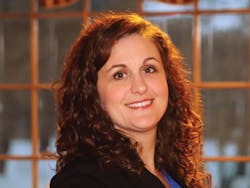Passing the baton: The value of a stellar handoff
Julie C. Whiteley, BS, RDH
As a practicing hygienist, I am always looking for ways to add value to the appointment and to help guide patients toward optimal care and better health. Hygienists are often in the position of being the first in the office to see patient conditions and developing patterns. Additionally, we build trusting relationships with patients. With the proper appointment length, we should receive an incredible amount of information during a routine visit.
When we break it down, we do the following things for patients:
• assess the general health and risk factors of the patient
• make observations from a comprehensive head and neck exam
• learn patients’ dental concerns and goals for their oral health, including function and esthetics
• evaluate the effectiveness of patients’ home-care routines
• determine the level of health (or disease) of periodontal structures
• observe hard tissue, including pathology such as wear, decay, signs of parafunctional habits, and the like
• gather information about patients’ beliefs, objections, dental IQ, concerns, fears, personality styles, etc.
When we compare the time we spend versus the time the doctor spends doing a periodic exam, we are in the position of getting more information from our patients. This information is incredibly valuable. The question is, what do we do with it?
© Petesaloutos | Dreamstime.com
As an educator and consultant, I have the opportunity to regularly observe in clinical environments. I also refer to my own practice experiences. I have noticed that a hygienist-doctor team with a solid handoff of information is more effective than one where the hygienist and doctor communicate with the patient separately. The purpose of this article is to discuss the benefits of a good handoff and how to implement this important patient communication tool in your practice. We will begin by looking at four important benefits.
Four benefits of a good handoff from the hygienist to the doctor
First, patients benefit from hearing the same information more than once during a visit.
When I became a clinical instructor, my mentor told me that students must hear something a minimum of three times before it “sticks.” I believe this same theory applies to patients.
We may be thorough when we explain conditions, concerns, and treatment options to patients throughout their appointments, but the reality is that they are not fully “getting it.” Consider those situations where you have had significant dialogue with a patient. When the doctor comes in for the exam, the patient acts as though he or she is hearing the information for the first time. I used to find this frustrating and took it as a sign that the patient had tuned me out and only wanted to hear what the doctor had to say. What I learned is that the patient may very well have been listening, but wasn’t able to fully grasp and retain the information the first time.
Consider this: Because of time constraints, we are often talking to patients instead of having a dialogue with them. While we are educating and explaining, they have little opportunity to respond or ask questions. Moreover, it may be difficult for them to fully concentrate, as they may be anticipating discomfort from the treatment and are distracted. Many patients have dental anxiety and fear, making it hard to focus. Also, most patients have an internal dialogue going on that is further preventing them from fully listening. As you are sharing information about their condition and proposed treatment options, they may be wondering about things such as the following:
• “How much does this cost?”
• “Will my insurance cover this?”
• “I’m not in pain. Why do I need treatment?”
• “This treatment sounds scary and painful.”
• “Is this treatment a real need or a ‘nice to have’ that brings in revenue for the office?”
And the list goes on.
When there is a solid handoff between the doctor and hygienist, it gives patients the opportunity to hear the same information a second time. It also gives them another chance to process the information, ask further questions, and state possible concerns. There is more opportunity for dialogue. This leads to the next point.
Second, a good handoff results in higher treatment-acceptance rates.
This additional dialogue allows us to address objections and helps us guide patients to more informed, educated choices regarding their dental health. The end result is often patients who are more compliant, have higher dental IQs, and understand the importance of the proposed treatment.
Third, consistency and trust are created around the recommended treatment when both the hygienist and doctor are expressing the same concerns and recommendations.
Consistent information that is expressed by two different providers helps the patient see the concern as a real concern. In addition, a sense of trust is created when the doctor and hygienist are seen as a cohesive, comprehensive team. For me, this dialogue with my doctors regarding patient care has added more satisfaction to my role. I am viewed as a well-educated, highly trained colleague. This is not only a benefit for me, but it further helps promote the importance of the role of the dental hygienist to the general public. We all know we do so much more than simply clean teeth, and a solid, consistent handoff helps showcase that we are educated, trained, licensed professionals who add incredible value to a practice and to the patients entrusted to our care.
Fourth, proper handoffs allow for more efficient use of valuable and limited appointment time.
It’s no secret that we are constantly running against the clock. With a solid handoff, time can be used more effectively. When a hygienist has already planted the seeds with a patient and provided a good overview to both the patient and doctor, the handoff allows the doctor to pick up where the hygienist left off, as opposed to starting the dialogue with his or her own observations during the exam.
We all know that hygienists in most states are not allowed to work independently and diagnose treatment, but we also know that we can discuss concerns and tell the patient what the doctor may recommend. This does not mean the doctor does not do an independent exam—it just means that time is used more efficiently. We are helping the doctor quickly get to the diagnosis and treatment recommendations for the patient. This maximizes the doctor’s time in the hygiene room without causing the hygienist to run behind.
Tips for a successful and seamless handoff
‘Pre-work’
It is best when the hygiene-doctor team decides in advance what areas should be “reported” during the handoff conversation. I recommend the following:
• health changes
• intraoral and extraoral exam (oral cancer screening, TMJ, etc.)
• current periodontal condition and if treatment may be needed (including history of past treatment)
• restorative concerns with photos and summary of what you discussed
• outstanding treatment status, including why the patient hasn’t committed to the previously proposed treatment
• complaints, including esthetic concerns
It is helpful to ask about esthetic concerns as part of the health history and dental review during your assessments, such as, “Are you satisfied with the appearance and function of your teeth?” Additionally, time should be taken to be sure the team is consistent. A good handoff requires that the doctor and hygienist are coordinated and calibrated regarding treatment philosophies.
Pregame huddle
When possible, particularly if there is an issue or concern, it is best for the hygienist to have a brief “pregame huddle” with the doctor before the exam. This is especially important in areas where the doctor may need some preparation. For example, perhaps a patient has a complaint about a recently placed restoration or is a patient refusing diagnostics and treatment in accordance with the standard of care. A brief, private discussion about this before the doctor enters the room can help the doctor be prepared to address the patient’s concerns.
The handoff
The actual handoff, if done well, is like a coordinated dance that is timed appropriately and where everyone knows their parts.
First, the hygienist has to have done his or her job in collecting good assessment data and discussing observations with the patient. The best way to do this is to say something to the patient such as, “Tom, I’m concerned with what I am seeing with the second tooth from the back on the upper left. I know you mentioned some sensitivity when you bite on that tooth. When I checked, you have a large silver filling that feels like it is starting to separate from your tooth. It appears there is also a crack. Let’s look at this photo together. We will bring it to Dr. Smith’s attention. He may recommend a crown to stabilize the tooth.” You can then explain a bit about what a crown is and why the doctor may recommend it. It’s also a good opportunity to discuss the risks that can come from an untreated cracked tooth.
The other essential component needed for a good handoff is that the doctor needs to ask for information from the hygienist before he or she starts the exam. By fast forwarding and starting the exam or asking a patient questions, a patient won’t see or benefit from solid teamwork, and he or she will repeat information already shared to the hygienist. The hygienist will also be much less likely to attempt the handoff going forward, as he or she may feel bypassed. Lastly, the doctor will be spending more time in the room, and the patient may be less likely to accept the treatment.
Where I have seen a handoff work best is when the doctor comes in, takes a moment to meet and greet the patient, and then asks the hygienist about the visit. The doctor might say, “Kathy, I know you and Tom just spent quite a bit of time gathering some information. Can you bring me up to speed?”
The clinical handoff would then continue, perhaps sounding something like this: “Dr. Smith, Tom and I did cover a lot. He is in good general health with no changes. The health of his gum tissue has improved in some areas, but I’m concerned that it’s worsened in others. We talked about the lower molar area, where there are some fours along with bleeding on probing. The bone height is normal, but we did observe some areas where the crestal bone is a bit fuzzy and discussed how this is the start of periodontitis. He tends to get more gumline plaque in that area, so we reviewed home-care tools and techniques that will hopefully help get that tissue back in shape and arrest the inflammation before it gets to a point of bone loss. I also recommend he come in at four months instead of six months to keep a closer eye on those borderline areas and we can reevaluate. When I did the hard-tissue charting, I noticed a crack on the distal of No.14. That tooth has a very large amalgam that appears to be percolating as well. Tom reports occasional nonlingering pressure sensitivity. I took some photos and we talked about the possibility of that tooth needing treatment that may consist of a crown. Of course, we wanted to check with you to see if you agreed. Tom also mentioned he feels the bonding on Nos. 8 and 9 is looking dark, and he’d like to discuss other treatment options with you. We discussed several options, including veneers, along with whitening. Tom wants to discuss this further with you.”
When doing the handoff and when the doctor asks how things are going, avoid short answers such as “good” or “status quo.” Give a descriptive statement, even when it’s good news, such as this: “Mary is doing very well. She is in excellent health and does a great job taking care of her teeth. She has a history of generalized slight bone loss, but she has been able to maintain the disease for years with a combination of good home care and more frequent recare. She is really pleased with the crown you placed on No. 30 and reports she’s happy with the function and appearance of her teeth. There is a watch on the amalgam on No. 12. I took a photo and x-rays today for your evaluation.”
If there are any areas of concern, don’t minimize what you’ve seen. Provide the patient and doctor with your observations, concerns, and ideas, always making it clear that the doctor does the definitive diagnosis and recommendation.
The second handoff
Just as the handoff between the hygienist and doctor is important, the handoff between the hygienist and business team is equally important. Patients should be escorted, and there should be a dialogue between the hygienist and business team member in front of the patient. This not only allows for a more streamlined, customer-focused process, but it allows the patient to hear the information a third time. The hygienst might say, “Tom and Dr. Smith discussed the importance of his getting a crown on No. 14, with the goal of scheduling as soon as possible as there is a large crack that is symptomatic. Tom would like to review the financials with you and said that next month would be an ideal time for him to get the treatment done. I’ve already made his next recall appointment.”
Lastly, documentation of what was discussed is critical. Be specific in terms of what was recommended, the patient’s response, and the next steps. Going forward, use the previous notes to follow up at the next visit. If the treatment was completed, it gives you an opportunity to ask the patient how it went. If the treatment wasn’t completed, you can readdress with a consistent message.
Final points
A solid handoff can be an invaluable tool in patient care. As hygienists, we spend a lot of time with patients, gathering critical and valuable information. Sharing that information in a comprehensive, concise way with the doctor in front of the patient allows us the opportunity to better communicate with our patients.
In my experience, this has not only made my job more satisfying and rewarding, but has allowed me to add value to the practice by helping the doctor more quickly assess, diagnose, and recommend appropriate treatment. The result is a practice with healthier, more knowledgeable patients who are more compliant with their dental health.
Working as a team to help guide patients toward optimal care results in healthier patients and a healthier practice. Our patients feel the thoroughness, appreciate the consistency and efficiency, and feel better cared for—and they are more likely to return and accept the treatment they need.
Julie C. Whiteley, BS, RDH, is a certified human resources specialist and a faculty member at Massachusetts College of Pharmacy and Health Sciences University. She has earned degrees in business administration and dental hygiene, and she has worked extensively in both fields. Bridging her knowledge and experience from business, clinical hygiene, and teaching, Whiteley delivers information and programs that enhance dental practices.


